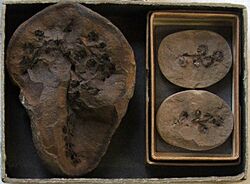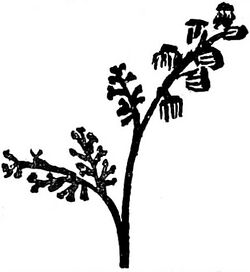Biology:Crossotheca
From HandWiki
| Crossotheca | |
|---|---|

| |
| Specimen P 30369 (left) and the pollen bearing organs of C. hughesiana from Dudley, England | |

| |
| Reconstruction of C. höninghausi | |
| Scientific classification | |
| Kingdom: | Plantae |
| Clade: | Tracheophytes |
| Division: | †Pteridospermatophyta |
| Class: | †Lyginopteridopsida |
| Order: | †Lyginopteridales |
| Genus: | †Crossotheca Zeiller (1883)[1] |
| Species | |
| |
| Synonyms | |
| |
Crossotheca is an extinct genus of seed ferns (Pteridospermatophyta) widespread in coal measures of Carboniferous, Permian and Triassic age,[8] with possible Devonian remains known from Belgium.[8][9] The type species is C. crepini, named and described in 1883 by R. Zeiller,[1] and the genus is known from fossils found in Belgium (?), Canada , China , England , France , Hungary, Ireland, Poland and the United States .[8]
One species, C. höninghausi, is the male fructification of Lyginodendron oldhami[5][9] and the same species is the microsporangia-bearing member of Lyginopteris.[5]
Description
A fertile Crossotheca branch shows the following features:[2][8]
- The branch tips are slightly expanded into a circular or paddle-shaped limb.
- At the tip of each branch there are a few bilocular sporangia attached together.
- Each sporangium contains a number of microspores (pollens).
References
- ↑ 1.0 1.1 1.2 Zeiller, R. (1883). Fruitifications de Fougèred du Terrain Houiller. Ann. Sci. Nat. 6e sèr. Bot. XVI, pp. 177-209
- ↑ 2.0 2.1 2.2 Kidston, Robert (1906). "On the microsporangia of the pteridosperms". The Royal Society Publishing 77 (515): 161–162. doi:10.1098/rspb.1906.0005. Bibcode: 1906RSPSB..77..161K.
- ↑ Potonie, R. (1954). Position of the Paleozoic spore genera in the natural system.
- ↑ F. L. S., Johnson, T. D. (1911). A seed-bearing Irish Pteridosperm, Crossotheca Höninghausi, Kidston (Lyginodendron oldhamium, Williamson). Royal Dublin Society
- ↑ 5.0 5.1 5.2 "Palaeobotany," Encyclopædia Britannica (11th ed.), v. 21, 1911, p. 536, fig. 28.
- ↑ Stubblefield, S.P., Taylor, T.N. and Daghlian, C.P., (1982). Compressed plants from the Lower Pennsylvanian of Kentucky (U.S.A.). I. Crossotheca kentuekiensis n. sp. Rev. Palaeobot. Palynol., 36: 197--204.
- ↑ Brongniart, A.T. (1849). Tableau des genres de végétaux fossiles considérés sous le point de vue de leur classification botanique et de leur distribution géologique. Dictionnaire Universel d'Histoire Naturelle. 13. 1-127.
- ↑ 8.0 8.1 8.2 8.3 Andrews, N. H. (1970). Index of Generic Names of Fossil Plants, 1820-1965. Geological Survey Bulletin 1-354
- ↑ 9.0 9.1 Jud, N. A. (2011). Unpublished taxonomic opinions.
Wikidata ☰ Q108387589 entry
 |

